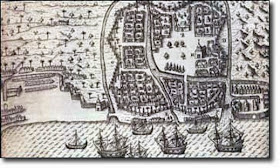Dutch surrender to Koxinga in 1661, an illustration from Frederic Coyett's memoir, "Neglected Formosa", published in 1675. Most likely, Koxinga himself did not attend the ceremony, who had informed Coyett that he would be watching from the hillside.
Taiwan has always been known for its limited resources which have always run short in one respect or another, depending on the times. The mission of Ming-Cheng, carried out by Koxinga and continued on by his son 鄭經Cheng Ching, was to fight against Qing and restore Ming [反清復明]. Tung Ning Kingdom therefore was not meant to be a self-contained, self-sufficient paradise on earth but a military base from which to launch attacks on China. The military actions required enormous investments in manpower, weaponry, equipment, warships, and logistics. Money coming in from the foreign trade had provided much of the support; however, with escalation of Chinese embargo and increasing Japanese isolationism, a shift towards exporting products of Taiwan became a necessity.
What Taiwan could offer at that time were sugarcane sugar, rice and grains, herbal medicine, and deer hides.
By Cheng Ching's time, sugar production was down to only 1/5 of that during the Dutch era. The annual production was only 1.7 million 斤 (one 斤 = 0.5kg) because the fields were re-tilled for much needed foodstuff. At times, however, the production was increased to 5 million 斤 in order to meet market demands in Japan and as far as Persia.
The annual production of whole deer hides was 200,000 pieces. According to a British East India Co report, male hides fetched a higher price at 20 pesos each and female, 16. They were all sold in Japan for 70 pesos apiece, however.
To prepare for war against the Qing, the Taiwanese were heavily taxed. The taxation system was that originated by the Dutch East India Co. Not only property and head taxes, there were also the ones for land and water uses. Land taxes included that for buildings, stone rice grinders, and groceries; water taxes included port utility, fish farms, and ship construction. After Cheng Ching, his heir 鄭克塽Cheng Ke-Suang even taxed straw huts. To avoid this tax and in protest, angry farmers destroyed 3 out of 10 of these structures.
The British East India Co reported in 1679 on the situation in Taiwan as being quite precarious, very difficult to repel the constant Qing harassment. And with dwindling state funds, heavy taxation must be imposed on the populace. Even so, the military needs could not be truly satisfied and a revolt by the underpaid soldiers was a real threat.
Gradually, Tung Ning Kingdom lost the support of its people. Throughout the Cheng rule, the Qing had offered favorable terms inviting Ming-Cheng to surrender. These were steadfastly refused by the Cheng Clan. Eventually, the war of attrition undid Ming-Cheng. The last King 鄭克塽, Koxinga's grandson then only 14 years old, yielded to Shi Lang on July 19, 1683. The entire Cheng Clan was held hostage in Beijing, and its soldiers, most of them seamen, banished to China to till barren lands in desolation. Shi Lang then became the biggest land owner and the harshest tax collector in the history of Taiwan. To this day, a Cheng is still prohibited from marrying a Shi woman.
In 1911, the corrupt Qing was finally overthrown and Rep of China born. Then in 1949, KMT lost the civil war to CCP and moved to Taiwan. The subsequent years are in many ways similar to the Tung Ning Kingdom, especially the reliance on foreign trade for economical survival and the never-ending threat of a takeover by force by China. History may provide some clue on how these may end.






